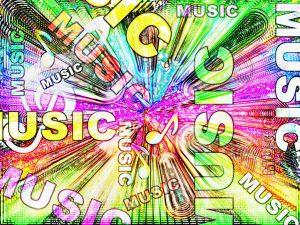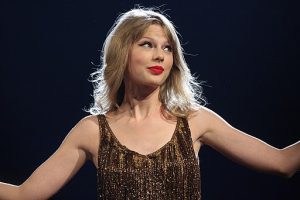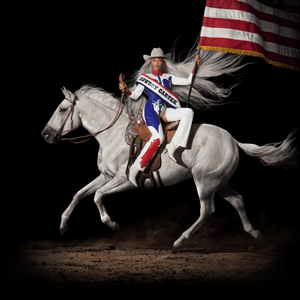12 Popular Music and American Culture
By Alyssa Riley
Music is a constant in my life, whether I’m listening to Kings of Leon while driving, the Lumineers while studying, Fleetwood Mac when getting dressed for a night out, or Frank Sinatra when cooking. I remain loyal to many of the musicians I grew up listening to, observing how their styles, sounds and brand images have changed over the years.

Recorded music ascended into American culture thanks to the inventions of the phonograph and gramophone. Of the many popular styles today – including but not limited to alternative, indie, bluegrass, rap, blues, contemporary pop, country and classic rock – there is at least one genre of musical culture for everyone. Recorded music is in films, in stores, on the radio, on smartphones, and on streaming services.
Music is part of our cultural identity and a universal language. Popular music allows people to dance and sing with others and feel connected through favorite songs. Much of this chapter offers a brief historical overview of American popular music’s evolution in the 20th century, beginning with the 1920s. At the end of the chapter, we’ll turn our attention to today’s musical landscape.
YOUR MEDIA LANDSCAPE
Outside of musical artists from your own generation, can you name an artist or band that you admire and identify with? Why do you feel this connection?
1920s
This decade was renowned for its excessive party lifestyle, technological advancements, an abundance of money and property after World War I, and resistance to Prohibition. A new generation, including flapper women, sought freedom from societal restrictions. The 1920s paved the way for the Golden Age of Radio and the emergence of jazz music.
A few years before the Roaring ’20s began, the Original Dixieland Jazz Band released the pioneering jazz recording “Livery Stable Blues.” Also, jazz artists King Oliver and Louis Armstrong changed the American musical landscape by incorporating African rhythms, gospel and blues.
To gain a sense of 1920s music, you can listen to Fascinating Rhythm: Great 1920s Vintage Jazz Music Hits (Past Perfect) on YouTube.
1930s:
Jazz became even more popular in the ’30s as jazz artists played on Mississippi River steamboats or performed illegally in speakeasies during the Prohibition era. Many Americans began viewing jazz music as immoral, claiming it threatened the country’s cultural values.
Alongside jazz was blues music, which originated when Black slaves adapted their musical heritage to the American environment. When the blues infiltrated Northern states in the late ’30s and early ’40s, it developed into specific regional styles: jazz-oriented Kansas City blues, swing-based West Coast blues, Chicago’s urban-style classic Southern blues, and more.
The following video shows Louis Armstrong and his touring band performing “Dinah” in 1933 in Copenhagen.
1940s
Thanks to a developing alliance between the sound recording and the radio industries, artists like Frank Sinatra and Ella Fitzgerald profited from wide exposure to listeners. Their popularity coincided with a renewed emphasis on American family values during and after World War II. Big-name artists like Bing Crosby, Sammy Kaye and the Andrews Sisters regularly referenced the military and the war, and the United Service Organizations (USO) enabled the big names in music to contribute to war efforts by performing for soldiers and their families.
Mixing sounds to appeal to both the returning soldiers and everyday Americans, rockabilly was born from the fusion of country with rhythm and blues. Alongside rockabilly, country music became more popular during this decade with the help of Western films and singing cowboys such as Roy Rogers and Gene Autry.
For a taste of the times, you can watch Frank Sinatra perform “Come Fly With Me” or learn more about the connection between movies and music in the careers of Roy Rogers and Gene Autry.
1950s
In 1955, the Top 40 format was born; radio station playlists were based on popularity (usually the Billboard Top 40 singles chart), and a popular song could be played as often as 15 times a day on the same station. Radio stations began influencing record sales, resulting in increased competition for spots on station playlists.
Elvis Presley became a radio and television phenomenon, especially after a 1956 television appearance on the Ed Sullivan Show. You can watch that performance below.
Unlike popular music predecessors such as Frank Sinatra, whose focus was primarily on singing and musicality, Elvis’s performances were far more visual. By today’s standards, Elvis Presley gyrating his hips in the ’50s seems tame, but it was extremely controversial among parents at the time and contributed to a generational gap in attitudes toward popular music of the day. In one of his television performances, his body wasn’t shown from the waist down. A few cities even sought to ban or cancel his performances due to “provocative music and suggestive dance moves.”
Many historians credit Elvis Presley with integrating popular music and rock ‘n’ roll. His musical style, heavily influenced by blues and rockabilly, paved the way for Black artists such as Chuck Berry and Little Richard to gain widespread popularity among white audiences.
Also, the birth of Motown Records in 1959 led to a best-selling ’60s mixture of soul and pop music by Black groups such as the Temptations and the Supremes with Diana Ross.
1960 and 1970s
Rock ‘n’ roll took flight in this decade. Although rock ‘n’ roll began primarily as an American genre, and many U.S. artists reached the top of the charts overseas, the Beatles’ overnight fame signaled what became known as music’s British Invasion.
The Beatles paved the way for other British bands to reach American charts, including the Kinks, the Zombies, the Animals, Herman’s Hermits and the Rolling Stones. Many bands shifted from pure pop to an intersection of urban rock and blues. A developing sub-genre was surf music, which was especially popular in California and is best heard through artists like the Beach Boys, Jan and Dean, and Dick Dale.
In the latter years of this decade, popular music reflected the emerging fault lines in American culture, such as civil rights, women’s rights, Vietnam War protests, and environmentalism. Folk music, which prioritized meaningful lyrics over elaborate musical style, became the genre of choice for much social activism. Early in his career, Bob Dylan was a musical leader in this genre.
Likewise, protest music became popular among the hippies of the ’60s, as many listeners of Jimi Hendrix and the Grateful Dead took to drug use for personal expression and freedom of speech. The belief was that mind-altering drugs could heighten the musical experience and create a bond between bands and their listeners. Romanticism of psychedelic culture, including its emphasis on free thinking and free living, came to a head at 1969’s Woodstock Festival in New York.
Below is a video of Jimi Hendrix performing his version of “The Star-Spangled Banner” at Woodstock.
You can also watch the following video to learn more about how the 1960s and its music changed America:
1980s AND 1990s
MTV, which stood for Music Television, launched in 1981 with a constant stream of single-song music videos, which soon placed more emphasis on entertaining visuals, dialing back on the social protest from the previous two decades. The ’80s can be described as a decade of digital innovation with electronic bands such as Eurythmics, Duran Duran and Depeche Mode.
R&B songs – performed by artists such as Michael Jackson, Barry White, Salt-N-Pepa and Diana Ross – regularly topped the music charts in the ’70s through the ’90s. Originally termed for recording companies to market to African American communities, R&B incorporated aspects of funk and soul music into a nationally popular genre. Branching out from R&B, hip-hop music boomed in the 1990s and included such notable performers as 2Pac, Biggie and Jay-Z.
Even today, R&B and hip-hop remain at the top of U.S. charts; the Billboard Hot 100 Songs of 2024 included works by Metro Boomin, Kendrick Lamar, Doja Cat and 21 Savage. Watch the following video to learn about the transformation of R&B and hip-hop through the decades.
IMPACTFUL IN THE 21ST CENTURY

When we think of musicians who have left their mark on American culture, many of the performers previously mentioned in this chapter come to mind, whether it’s due to boy-band frenzies, sexual awakenings or rebellion.
Fifty years from now, when someone is writing a summary of American music and culture, which of today’s musical artists will be prominently mentioned? Ed Sheeran, The Weeknd, or Selena Gomez? Is it someone whose artistry is not yet fully recognized? Ultimately, the determination will be about more than sales, revenue and social media. It will also involve subjective judgment, through the lens of time, about artists who had a lasting impact on society’s attitudes and norms.
One artist who has clearly influenced 21st-century pop culture is Taylor Swift. Since her debut in 2006, she has won 14 Grammys, and in 2023 she was named Time’s Person of the Year, a title never given to the Beatles or Elvis Presley.
In 2024, Swift released her 11th studio album, The Tortured Poets Department, which debuted at No. 1 on the Billboard album chart. Only the Beatles have more No. 1 albums than Swift.
Despite her reputation for writing breakup and love songs, Swift’s music includes storytelling and folklore in a wide range of genres – country, pop, rock, indie folk, and alternative/indie. For many fans, she created a globally popular culture of girlhood, friendship, longing, regret, innocence, and revenge.
You can learn more by watching The Evolution of Taylor Swift’s Music | Good Morning America (YouTube)

Another influential artist is Beyoncé, who is not only a singer but also a songwriter, actor and entrepreneur. She has been building her career since leading and writing songs for the ’90s musical group Destiny’s Child. Starting her solo career in 2003 with her first album Dangerously In Love, Beyoncé has won 35 Grammys, the most in Grammy history, and appeared in numerous movies. In 2024, she even released a country album, titled Cowboy Carter, to critical acclaim.
Watch Beyoncé – The Music Evolution to learn more.
Will both Taylor Swift and Beyoncé be artists who are remembered 50 years from now for having a strong impact on American culture? Their repertoires suggest that the answer may be yes.
THE DEVIL’S MUSIC
Beginning as early as the 1950s, some evangelical Christians in the United States complained that rock ‘n’ roll music was satanic. In an academic essay titled “The Devil Has the Best Tunes,” Nathan Dickey examined this phenomenon, including the following excerpt from Eric Holmberg’s documentary Hell’s Bells.
Like an invisible cancer that inevitably leads to death, so the satanic seed in rock and roll has culminated in a blatant obsession with the occult. Cryptic allusions to the Devil in the music of Blues artist Robert Johnson a generation ago have given place to an open worship of Satan and hell that comes complete with the symbols, liturgies, rituals, and messianic personalities that attend any religious order. No longer the stuff of small underground cults, millions of young people have been caught in its evil sway.
Over the decades, some musicians have embraced this cultural conflict in their music. For example, the Rolling Stones’ “Sympathy for the Devil” can still be heard on classic rock radio stations today.
Also, a few evangelicals suggested that the most offensive rock songs, when played backward, yielded Satanic messages. As an amusing response, in 1975 the band Electric Light Orchestra released the song “Fire on High,” which included an eerie opening with a backwards message that (in reverse) said: “The music is reversible, but time is not. Turn back! Turn back!”
More recently, Sam Smith wore a devil costume with plastic horns sticking out of a top hat while performing the song “Unholy” with Kim Petras at the 2023 Grammy Awards show. Some conservatives criticized the outfit, but Smith gained free publicity along with increased name recognition as a result of the performance. The “Montero (Call Me By Your Name)” music video by Lil Nas X received similar criticism in 2021 for being immoral and harmful to children, mainly because it appeared to encourage devil worshipping.
PERSPECTIVE – BEYOND U.S. BORDERS
In the 1950s, Elvis Presley was threatened with jail time for his allegedly obscene dancing. For an expanded global understanding of how popular music and dance can impact culture and be a form of protest today, it may help to step outside of the United States and look toward Iran. Multiple news outlets reported that the five Iranian girls in the video below were detained for dancing to a Selena Gomez song and having their heads uncovered.
Also, Instagram videos such as the one below, featuring an Iranian nicknamed Booghy, led to the arrests of 12 men in late 2023. The New York Times reported that Booghy “was detained for several hours and accused of instigating against the government. As part of the crackdown police swarmed street musicians performing in Rasht, arrested some and confiscated their instruments.” To conservative Iranians, dancing can be interpreted as a symbol of civil disobedience.
Similarly, a dissident rapper in Iran was charged with “spreading corruption on earth’ and “propaganda against the state.” He was sentenced to death in 2023, but that sentence was overturned in 2024.
CLOSING THOUGHT
Popular music as far back as the 1920s pushed against social standards of the day. For at least a century, U.S. parents and other adults have complained about kids’ music and dancing. One could argue it’s become part of American culture.
ADDITIONAL VIDEO LINKS
We’ll close this chapter with some additional examples of how music crosses American media boundaries. Here are some video links that show the cultural intersection of music, television and fashion for younger audiences.
American Bandstand – Top 10 from one week in 1969
Soul Train – Line dancing to Michael Jackson’s 1979 hit “Don’t Stop Til You Get Enough”
Midnight Special – David Bowie and Marianne Faithfull in 1973
TRUE or FALSE
The following questions highlight a few tidbits of information from the chapter. Use the forward button to advance through the questions.
MUSIC AND CULTURE – LIVING HISTORY
Now is your turn to collect some living history about music and culture.
Interview someone whose lifetime has spanned a broad spectrum of changes in popular music. Age 50 is probably a minimum, but the older the better.
In most journalism settings, it is not appropriate to interview family members and friends, but for this assignment it is OK. Do not interview your parents or guardians. Grandparents could work well, though, if available.
Visit with your interviewee about how their consumption of popular music has evolved over the past decades, both through technology and their own personal musical tastes. How and when did they listen to music and find new artists when they were younger, and in what ways has that changed over the years?
You also may be interested in learning roughly how much they spent on purchasing music over the years, and what formats they bought (8-track and cassette tapes, vinyl records, CDs, mp3s, streaming services).
You should ask questions about the extent to which the music they enjoy helps define their personal identity or their generation.
Summarize the highlights and key takeaways from your interview in a short narrative of approximately six to eight paragraphs, with three or four sentences per paragraph. There is no template for your writing, but be sure to include the most interesting information that you gleaned from the interview.
Reminder — Do NOT use large-language models such as ChatGPT or other AI tools to generate content for this assignment.

